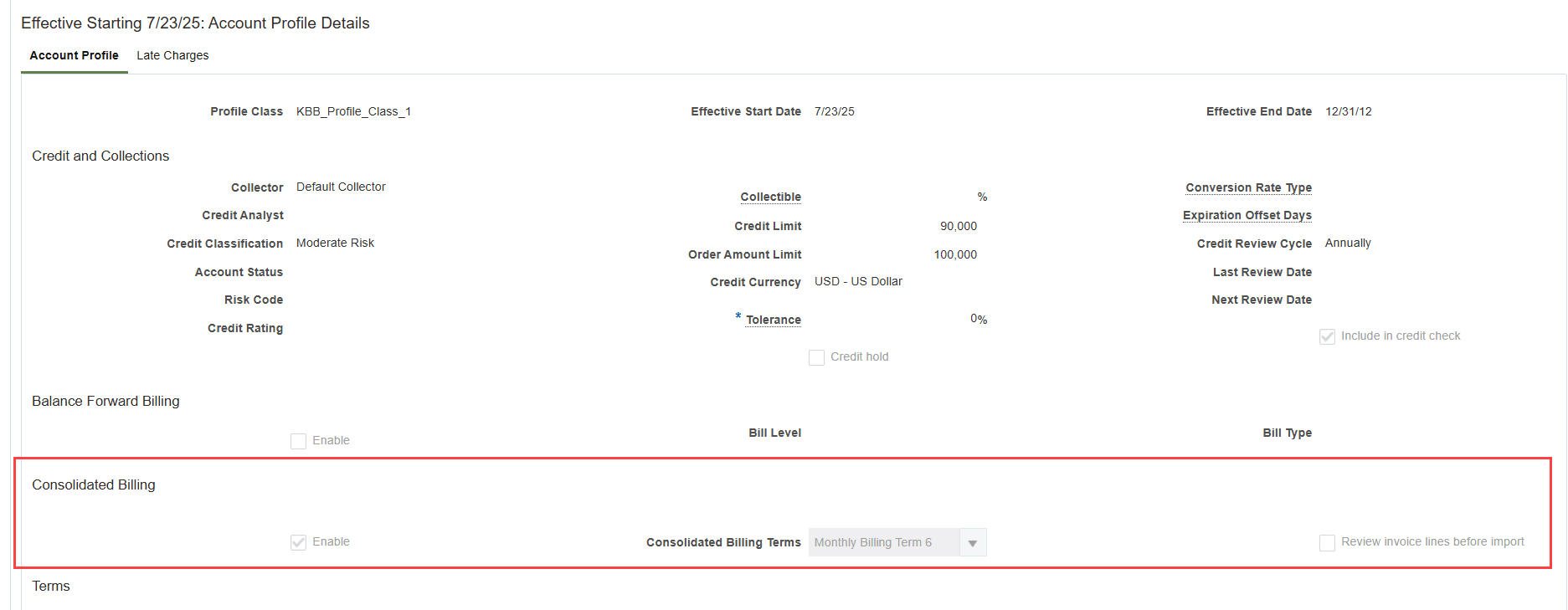Consolidated Invoices with Charges from Multiple Sources
Generate invoices by consolidating charge lines from multiple sources based on predefined frequencies. Billing specialists can review draft lines and make corrections before generating the final invoice.
Business benefits include:
- Enhances billing efficiency by consolidating invoice lines from multiple sources into a single billable transaction.
- Streamlines cash applications with potentially reduced transaction volumes.
- Supports proactive charge line validation, helping to minimize disputes and post-invoice adjustments.
- Augments the collections process and cash flow management.
Steps to Enable and Configure
To enable this feature you need to log a Service Request (SR).
- After entering the promotion code, enable the feature opt-in from Financials > Customer Invoice Processing.
- Navigate to the Consolidated Billing section of the applicable customer account profile -
- Set the Enable option.
- Associate the billing terms to specify the criteria to be applied for consolidation.
- Optionally enable the Review of Invoice Lines Before Import.
- Repeat these steps for each customer account.

Customer Account Profile
- Schedule the ESS Jobs in this order to run at periodic intervals -
- Import Receivables Transactions using AutoInvoice (Using feeder system sources): Identifies lines eligible for consolidation.
- New ESS Job: Consolidate Charge Lines for Invoice Import Into Receivables (Using the source ORA_Consolidated Invoice): Groups eligible lines for review or invoicing based on Billing Terms.
- Import Receivables Transactions using AutoInvoice (Using the source ORA_Consolidated Invoice): Creates consolidated invoices.
Enabling Consolidation at the Customer Account Profile Level
You can enable consolidation at the customer account profile level using the following methods:
-
Manual update through UI:
-
Update the customer profile in the new Consolidated Billing section under Customer Account > Profile History.
-
-
Profile Class Updates via UI:
-
Modify customer profile classes and propagate changes to customer profiles using the Manage Receivables Customer Profile Classes task, now accessible from the Customers section in the Billing work area.
-
Three update options are available:
-
Apply changes to new profiles only.
-
Apply changes to unmodified profiles and version existing unmodified profiles.
-
Apply changes to all profiles and version all existing profiles.
-
-
-
Mass Update via FBDI (File-Based Data Import)
-
Populate new attributes in the RA_CUSTOMER_PROFILES_INT_ALL tab within the FBDI template through columns DZ to EB.
-
-
SOAP Service Integration
-
Create or update customer profiles using the available SOAP service.
-
NOTE: It is recommended to review the details before propagating the revisions on profile classes to customer profiles, especially when the update option is set to 'Apply changes to all profiles and version all existing profiles', as it can potentially update other attributes which were modified earlier.
Managing Consolidated Billing Terms
To set up consolidated billing terms for customers:
-
Navigate to the Manage Consolidated Billing Terms task from the Consolidated Billing section in the Billing work area.
-
Use the VB Excel interface to configure customer-specific options. Key settings include:
-
Consolidation Method: Select “Time-based.”
-
Billing Cycle: Define billing frequency (daily, weekly, monthly), choose specific days for processing, or select the last day of the month, with an option to skip weekends.
-
Inclusions: Specify transaction sources to include in the consolidation.
-
Exclusions: Define exclusion criteria such as payment terms, receipt methods, business units, and legal entities.
-
Managing the Consolidation Process
You can manage consolidation-related activities through the new Manage Draft Consolidated Bills (ADFdi) task, available in the Consolidated Billing section of the Billing work area. It allows to -
-
Review charge lines before invoice import.
-
Perform ad hoc billing.
NOTE: Consolidated invoices will not be created if any charge line for a customer account contains errors. All errors must be resolved using the existing Manage AutoInvoice Lines (ADFdi) task before proceeding with Invoice creation.
Tips And Considerations
- It is recommended to clear all pending interface lines for a customer by running the ESS Job 'Import Receivables Transactions using AutoInvoice' before enabling consolidation.
- You can only consolidate charge lines from these sources: Oracle Order Management, Oracle Subscriptions, and External Sources (interfaced via FBDI/Web Services).
- Use only 'Import Receivables Transactions using AutoInvoice' ESS Job when consolidation is enabled. Replace any schedules that use 'Import AutoInvoice' Job.
- Consolidated invoices are generated using the seeded transaction source ORA_Consolidated Invoice. Charge lines belonging to different feeder systems are captured as invoice lines. The transaction source interfaced by feeder system is shown as 'Line Transaction Source' on each invoice line.
- All charge lines for a customer account within a billing cycle are consolidated into an invoice. However, if any mandatory grouping attributes differ (such as currency, transaction type, or billing site), separate invoices will be created. To generate a single invoice for a billing cycle, ensure feeder systems pass charge lines with the same mandatory grouping attributes. Refer to the Key Resources section for the full list of these attributes.
NOTE: The attributes Purchase Order, Purchase Order Revision, Purchase Order Date, Comments, and Internal Notes are excluded from the mandatory grouping for the lines intended for consolidation. These details are captured as references on invoice lines.
Key Resources
- List of mandatory grouping attributes are available here.
Access Requirements
You need the following privileges to perform activities relating to consolidated billing -
- Submit AutoInvoice Import Process (AR_SUBMIT_AUTOINVOICE_IMPORT_PROCESS_PRIV): Grants access to the new ESS process Consolidate Charge Lines for Invoice Import Into Receivables.
- Manage Consolidated Billing Terms (AR_MANAGE_CONSOLIDATED_BILL_TERMS_PRIV): Provides access to the VB Excel-based task Manage Consolidated Billing Terms.
- Manage Draft Consolidated Bills (AR_MANAGE_DRAFT_CONSOLIDATED_BILLS_PRIV): Enables access to the new ADFdi-based task Manage Draft Consolidated Bills.